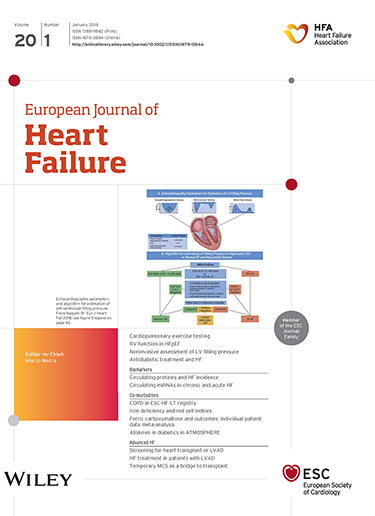心衰恶化的住院和门诊管理的临床和财务意义
IF 16.9
1区 医学
Q1 CARDIAC & CARDIOVASCULAR SYSTEMS
引用次数: 0
摘要
目的对于恶化心衰(WHF)的不同住院和门诊管理策略的临床和财务意义知之甚少。本分析旨在比较美国临床实践中不同类型住院和门诊WHF事件后的临床结果、家庭时间和医疗保健支出。方法和结果:我们在2010年至2018年的指南-心力衰竭登记处调查了65岁及以上因心力衰竭住院出院的美国医疗保险受益人。12个月内发生WHF的患者按首次事件类型分为4个相互排斥的组:HF住院、急诊科(ED)就诊并出院、观察住院和门诊静脉(IV)利尿。在每种WHF事件发生后,对随后12个月的死亡率、居家时间(存活和离开任何医疗机构的天数)和医疗费用进行比较。在美国553家医院的18827例HF住院患者中,6159例(33.6%)患者在12个月内发生了后续WHF事件。其中,48612人因心衰住院(79.5%),8139人(13.3%)因急诊科就诊,1767人(2.9%)因观察住院,2641人(4.3%)因门诊静脉利尿剂就诊。HF住院后12个月死亡率最高(累计发病率[IR] 48.8;95%可信区间[CI] 48.3-49.3),最低随访观察单位停留时间(IR 29.9;95% CI 27.7-32.0), ED放电后为中度(IR 41.2;95% CI 40.1-42.3)和门诊静脉利尿剂就诊(IR 39.3;95% ci 37.4-41.2)。HF住院后12个月的中位住家时间(25 - 75)最短(251[47-351]天),最长(354[206-365]天)。对于WHF事件本身,心力衰竭住院的平均每位患者总费用最高(11335美元),门诊静脉利尿剂就诊的平均每位患者总费用最低(259美元)。在WHF事件发生后的12个月内,当计算所有患者(包括12个月内死亡的患者)的费用时,门诊静脉利尿剂就诊后每位患者的平均总费用最高(29173美元)。在WHF后存活12个月的患者中,门诊静脉利尿剂治疗后每位患者的平均总费用(29931美元)与HF住院治疗(30971美元)同样高。结论:在这项针对美国老年人的全国性分析中,无论住院或门诊治疗,WHF后死亡率高,在家时间大幅减少,但HF住院后情况更糟。门诊静脉利尿剂是最便宜的初始治疗策略,但在随后的12个月里,相关费用与HF住院后的费用相似或更高。本文章由计算机程序翻译,如有差异,请以英文原文为准。
Clinical and financial implications of inpatient and outpatient management of worsening heart failure
AimsLittle is known regarding the clinical and financial implications of varying inpatient and outpatient management strategies for worsening heart failure (WHF). This analysis aimed to compare clinical outcomes, home‐time, and healthcare expenditure following various types of inpatient and outpatient WHF events in US clinical practice.Methods and resultsWe examined US Medicare beneficiaries 65 years and older discharged from a hospitalization for heart failure (HF) in the Get With The Guidelines‐Heart Failure registry from 2010 to 2018. Patients developing subsequent WHF within 12 months were divided into four mutually exclusive groups by type of first event: HF hospitalization, emergency department (ED) visit with ED discharge, observation stay, and outpatient intravenous (IV) diuretic clinic visit. Following each type of WHF event, mortality, home‐time (days alive and out of any healthcare institution), and healthcare costs were compared over the subsequent 12 months. Among 181 827 eligible patients discharged alive from a HF hospitalization across 553 US hospitals, 61 159 (33.6%) patients had a subsequent WHF event within 12 months. Of these, 48 612 were managed with HF hospitalization (79.5%), 8139 (13.3%) with an ED visit, 1767 (2.9%) with an observation stay, and 2641 (4.3%) with an outpatient IV diuretic visit. Rates of 12‐month mortality were highest following HF hospitalization (cumulative incidence rate [IR] 48.8; 95% confidence interval [CI] 48.3–49.3), lowest following observation unit stay (IR 29.9; 95% CI 27.7–32.0), and intermediate following ED discharge (IR 41.2; 95% CI 40.1–42.3) and outpatient IV diuretic visit (IR 39.3; 95% CI 37.4–41.2). Median (25th–75th) 12‐month home‐time was lowest following HF hospitalization (251 [47–351] days) and highest following observation unit stays (354 [206–365] days). For the index WHF event itself, median total per‐patient costs were highest for HF hospitalization (US$11 335) and lowest for outpatient IV diuretic visit (US$259). Over the 12 months following the WHF event, when accounting for costs of all patients including those who died within 12 months, the median total per‐patient costs were highest following outpatient IV diuretic visits (US$29 173). Among patients surviving 12 months after WHF, median total per‐patient costs following an outpatient IV diuretic visit (US$29 931) versus HF hospitalization (US$30 971) were similarly high.ConclusionsIn this nationwide analysis of older US adults, high rates of death and substantial reductions in home‐time occurred following WHF regardless of inpatient or outpatient management, but were worse following HF hospitalization. Outpatient IV diuretic administration was the least expensive initial management strategy, but over the subsequent 12 months, associated costs were similar or higher than costs following HF hospitalization.
求助全文
通过发布文献求助,成功后即可免费获取论文全文。
去求助
来源期刊

European Journal of Heart Failure
医学-心血管系统
CiteScore
27.30
自引率
11.50%
发文量
365
审稿时长
1 months
期刊介绍:
European Journal of Heart Failure is an international journal dedicated to advancing knowledge in the field of heart failure management. The journal publishes reviews and editorials aimed at improving understanding, prevention, investigation, and treatment of heart failure. It covers various disciplines such as molecular and cellular biology, pathology, physiology, electrophysiology, pharmacology, clinical sciences, social sciences, and population sciences. The journal welcomes submissions of manuscripts on basic, clinical, and population sciences, as well as original contributions on nursing, care of the elderly, primary care, health economics, and other related specialist fields. It is published monthly and has a readership that includes cardiologists, emergency room physicians, intensivists, internists, general physicians, cardiac nurses, diabetologists, epidemiologists, basic scientists focusing on cardiovascular research, and those working in rehabilitation. The journal is abstracted and indexed in various databases such as Academic Search, Embase, MEDLINE/PubMed, and Science Citation Index.
 求助内容:
求助内容: 应助结果提醒方式:
应助结果提醒方式:


